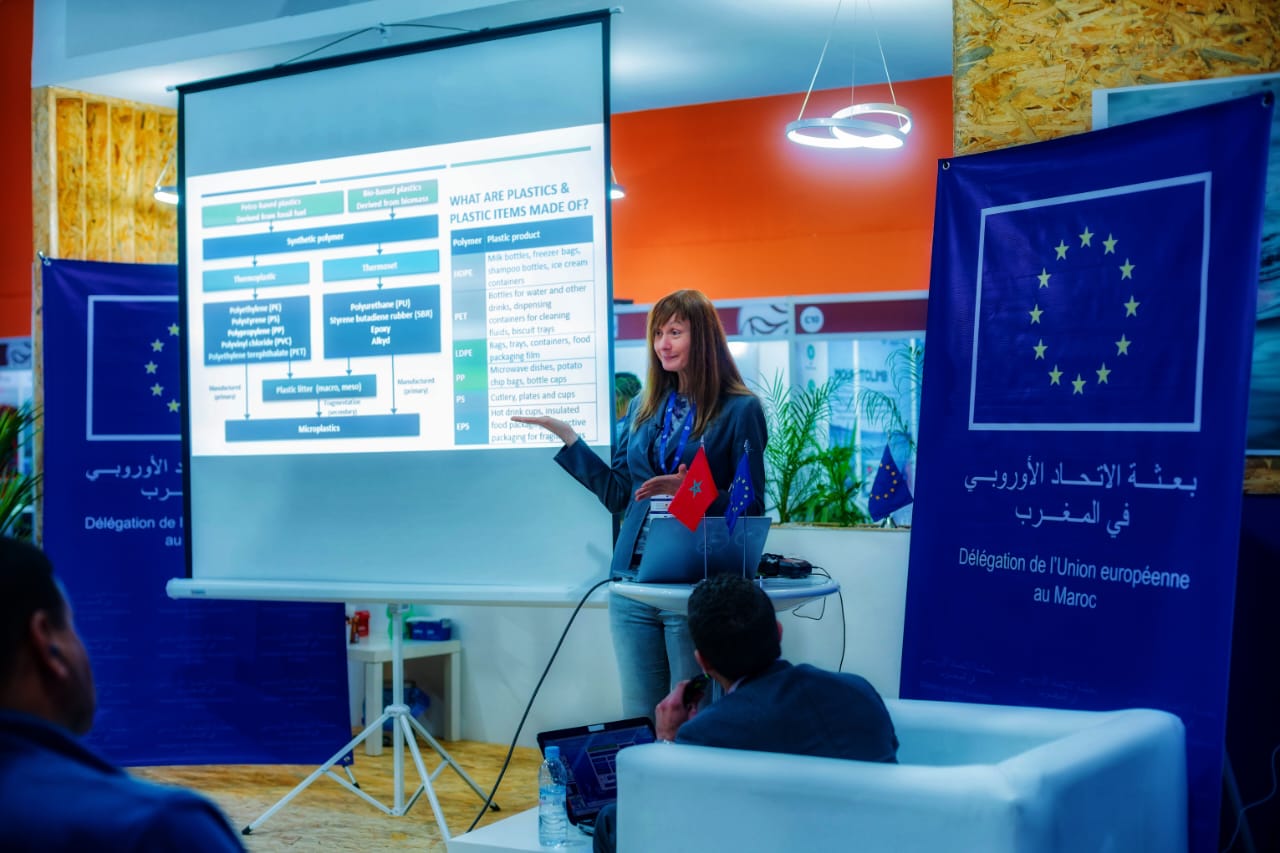 The Mediterranean Sea, a biodiversity hotspot and a key economic region, is under increasing threat from marine plastic pollution. Recognizing this growing planetary boundary threat, experts are accelerating efforts to move from research and policy to real-world, science-driven solutions.
The Mediterranean Sea, a biodiversity hotspot and a key economic region, is under increasing threat from marine plastic pollution. Recognizing this growing planetary boundary threat, experts are accelerating efforts to move from research and policy to real-world, science-driven solutions.
At the 7th Edition of the Halieutis Fair organized from 6 to 9 February 2025 in Agadir, Morocco, these critical issues were addressed in two sessions at the EU exhibition booth, featuring Dr. Thomais Vlachogianni, Senior Policy/Programme Officer at MIO-ECSDE. With extensive experience in marine litter actions on the science-policy-society interface, she was invited by the EU Delegation to Morocco, to share insights from her engagement in a large number of EU funded marine litter projects, such as the ENI CBC Plastic Busters CAP, the Interreg Med Plastic Busters MPAs, the WES project, the SWIM-H2020 SM and many others.
Dr. Vlachogianni emphasized the urgency of reliable and fit-for-purpose data, the wise use of plastic, and debunking the misconceptions about plastic pollution solutions. She highlighted key cutting-edge initiatives, including the Horizon Europe SOS-ZEROPOL2030 and Interreg IPA ADRION TETHYS4ADRION projects. The first is paving the way for addressing the emerging threat of tire wear particles in the Mediterranean (read more here), while the latter focuses on riverine litter inputs in the Adriatic and Ionian seas (read more here).
 The Mediterranean remains one of the most affected regions globally, with litter densities comparable to major oceanic gyres. The UNEP/MAP Quality Status Report reveals that the vast majority of beaches (84% to 86%) in three of the four Mediterranean subregions -the Adriatic, Eastern Mediterranean, and Western Mediterranean- fail to meet Good Environmental Status. In contrast, the Central Mediterranean recorded the highest percentage of beaches in Good Environmental Status, at 32%. A closer analysis of the data indicates that the Eastern Mediterranean is the most affected by beach litter, with 64% of surveyed beaches in poor or bad condition. The Adriatic and Western Mediterranean follow closely, with 60% and 58% of beaches in poor or bad condition, respectively.
The Mediterranean remains one of the most affected regions globally, with litter densities comparable to major oceanic gyres. The UNEP/MAP Quality Status Report reveals that the vast majority of beaches (84% to 86%) in three of the four Mediterranean subregions -the Adriatic, Eastern Mediterranean, and Western Mediterranean- fail to meet Good Environmental Status. In contrast, the Central Mediterranean recorded the highest percentage of beaches in Good Environmental Status, at 32%. A closer analysis of the data indicates that the Eastern Mediterranean is the most affected by beach litter, with 64% of surveyed beaches in poor or bad condition. The Adriatic and Western Mediterranean follow closely, with 60% and 58% of beaches in poor or bad condition, respectively.
A shift from problem identification to ‘on-the-ground’ tailored solutions is crucial. A plethora of plastic prevention and mitigation showcases exist in the Mediterranean, and it is crucial to fully leverage the wealth of knowledge generated through collective multi-stakeholder learning. Some of the solutions highlighted by MIO-ECSDE’s Programme/Policy Officer, include:
✅ Promoting reusable alternatives (e.g., setting up a reusable cup delivery system for beach bars)
✅ Developing sustainable business networks (e.g., a SUPs-free network of coastal food & beverage outlets)
✅ Implementing effective waste management schemes, including derelict fishing gear collection and recycling programs
A source-to-sea approach was underscored as critical, ensuring interventions address pollution at its origin. Dr. Vlachogianni called for a balance between technological and social innovations to curb plastic pollution effectively.
The discussions at Halieutis Fair 2025 reinforced the need for multi-stakeholder collaboration in advancing sustainable solutions for a plastic-free Mediterranean.
Read in French here